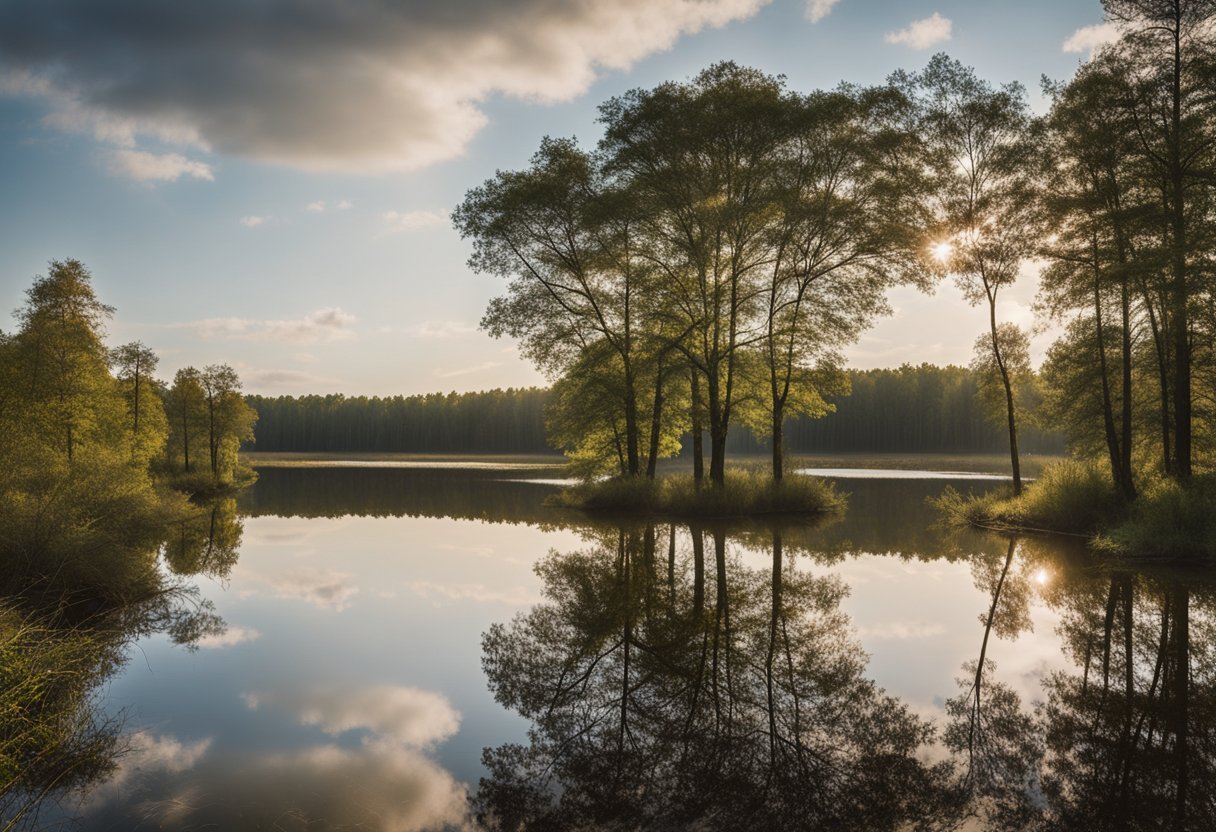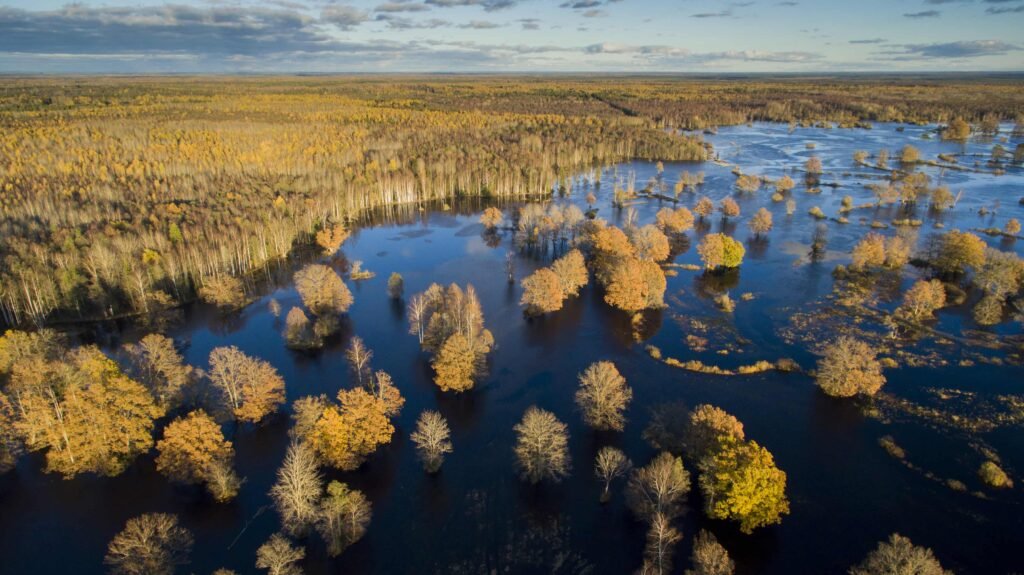
Soomaa National Park is a protected area located in south-western Estonia. The park spans 390 km² and was established in 1993 to preserve the unique natural features of the area. Soomaa, which means “land of bogs,” is a Ramsar site of protected wetlands and an Important Bird Area, making it an important ecosystem for both plants and animals.
One of the most unique features of Soomaa National Park is its fifth season, which occurs during the spring thaw when water floods all the lower forests, riverbeds, roadways, and even backyards. This flooding can cover up to 17,500 hectares of the park’s total area, creating a stunning and surreal landscape. Visitors can witness this natural phenomenon and experience the park’s diverse flora and fauna through guided hikes and other outdoor activities.
Soomaa National Park is a popular destination for nature lovers and outdoor enthusiasts. Its untouched wilderness, diverse wetlands, and unique seasonal flooding make it a must-see destination for anyone visiting Estonia. With its commitment to preserving the natural beauty of the area, Soomaa National Park is a shining example of sustainable tourism and environmental conservation.
Overview of Soomaa National Park

Soomaa National Park is a protected area located in the southwestern part of Estonia. The park was established in 1993 to preserve the unique natural and cultural heritage of the region. It covers an area of 390 km² and is managed by the State Forest Management Centre.
The name “Soomaa” means “land of bogs” in Estonian, and the park is home to some of the largest and most pristine wetlands in Europe. The park’s landscape is characterized by extensive bogs, rivers, flood-meadows, and forests. It is a paradise for nature lovers and outdoor enthusiasts, offering a wide range of activities such as canoeing, hiking, and wildlife watching.
The park is divided into five different zones, each with its own distinct features and attractions. These zones are Kuresoo, Valgeraba, Öördi, Ilmjärve, and Riisa. Each zone has designated trails and facilities for visitors to explore and enjoy the park’s natural beauty.
In addition to its natural wonders, Soomaa National Park is also rich in cultural heritage. The region has been inhabited for thousands of years, and evidence of human activity can be found throughout the park. Visitors can explore the park’s historic sites, such as the Kuresoo bog boardwalk, which was built by local villagers in the early 20th century.
Overall, Soomaa National Park is a must-visit destination for anyone interested in nature, wilderness, and the rich cultural history of Estonia’s southwestern region.
Unique Features of the Park
Soomaa National Park is a unique destination that offers visitors a chance to explore the diverse range of habitats found in Estonia. From bogs and wetlands to rivers and lakes, the park is home to a wide variety of flora and fauna that can be found nowhere else in the world. Here are some of the unique features of the park:
The Fifth Season
One of the most unique features of Soomaa National Park is the fifth season, which occurs during the spring floods. During this time, the park becomes a vast wetland, with water covering much of the landscape. Visitors can explore the park by canoe or kayak, and see the floodplain forests and meadows that are home to a variety of wildlife.
Bogs and Wetlands
Soomaa National Park is home to a variety of bogs and wetlands, including the Kuresoo Bog and the Riisa Bog. These protected wetlands are home to a variety of plants and animals, including the rare iris sibirica and gladiolus imbricatus. Visitors can explore the bogs on foot or by canoe, and see the unique landscape that has been shaped by thousands of years of natural processes.
Rivers and Lakes
The park is also home to several rivers and lakes, including the Raudna River. These bodies of water are home to a variety of fish and other aquatic animals, and offer visitors a chance to explore the park by boat or kayak.
Flora and Fauna
Soomaa National Park is home to a variety of animals, including roe deer, wild boar, beavers, lynx, golden eagles, elk, and brown bears. The park is also home to a variety of plants, including paludified forests and raised bogs.
Dunes and Flood Plain Grasslands
In addition to its wetlands and forests, Soomaa National Park is home to a variety of other habitats, including dunes and flood plain grasslands. These unique landscapes are home to a variety of plants and animals, and offer visitors a chance to explore the park’s diverse range of habitats.
Overall, Soomaa National Park is a unique destination that offers visitors a chance to explore the diverse range of habitats found in Estonia. Whether you’re interested in exploring the park’s wetlands, forests, or other habitats, there’s something for everyone to enjoy.
Activities and Visitor Information

Soomaa National Park offers a variety of activities for visitors to enjoy. Here are some of the most popular activities available in the park:
Hiking and Trails
Soomaa National Park has a number of hiking trails that allow visitors to explore the park’s natural beauty. The trails range from easy walks to more challenging hikes, so there is something for everyone. Some of the most popular hiking trails include the Kuresoo Bog Study Trail, the Riisa Nature Trail, and the RMK Hiking Route.
Canoeing and Kayaking
One of the best ways to explore Soomaa National Park is by canoe or kayak. The park’s rivers and bogs offer a unique and beautiful landscape that can only be fully appreciated from the water. Guided canoe trips are available for those who want to learn more about the area and its cultural heritage.
Winter Activities
Soomaa National Park is a great place to visit in the winter months. Visitors can enjoy snowshoeing, skiing, and other winter sports. The park’s visitor centres offer information on safe winter activities and guided trips.
Visitor Centres
Soomaa National Park has several visitor centres where visitors can learn more about the park’s history, culture, and nature education. The visitor centres offer a range of services, including library access, campfire sites, and guided trips. The centres are a great place to start your visit to the park and get information on the best hiking trails, canoe routes, and other activities.
Overall, Soomaa National Park is a charming and safe place to visit for those who love nature and outdoor activities. With its hiking trails, canoe routes, and winter sports, there is something for everyone to enjoy.
Transportation and Access
Soomaa National Park is located in Viljandi County, Estonia. The easiest way to get to Soomaa National Park is by car. There are main roads going to the national park from Tartu and Pärnu, two of Estonia’s main cities. Once in the national park, the road becomes a dirt road limited to 30km/h. Visitors should exercise caution when driving on the dirt roads, especially during the rainy season when they can become muddy and slippery.
For those who do not have access to a car, there are public transportation options available. The closest major city to Soomaa National Park is Pärnu, which is approximately 50km away. Visitors can take a bus from Pärnu to the town of Tori, which is located near the park. From Tori, visitors can take a taxi or arrange for a pick-up service to take them to the park.
Alternatively, visitors can take a bus from Viljandi to the town of Kõpu, which is also located near the park. From Kõpu, visitors can arrange for a pick-up service to take them to the park. It is important to note that public transportation options may be limited, especially during the off-season, so visitors should plan accordingly.
Once inside the park, visitors can explore the park on foot, by bike, or by canoe. There are several hiking trails and cycling routes throughout the park, and visitors can rent canoes from local operators to explore the park’s wetlands. It is important to note that visitors should always follow park regulations and stay on designated trails to protect the park’s delicate ecosystem.
Conservation Efforts and Recognition
Soomaa National Park is committed to preserving its unique ecosystem through sustainable tourism practices that minimize negative impacts on the environment. The park has been recognized for its efforts in conservation and has received several awards.
Soomaa National Park is a Natura 2000 area since 2004, which means that it is a part of a network of protected areas across Europe that promotes the conservation of biodiversity. The park is also an Important Bird Area since 1989, which recognizes its importance for bird conservation. In addition, Soomaa is a Ramsar site of protected wetlands since 1997, which recognizes its significance as a wetland of international importance.
Soomaa National Park has also been recognized for its commitment to sustainable tourism. The park is a member of the European Charter for Sustainable Tourism in Protected Areas and has been certified by PAN Parks in 2009, which is a European-wide network focusing on the protection of wilderness areas, the continent’s most undisturbed areas of nature.
Furthermore, Soomaa National Park has been awarded the European Destination of Excellence (EDEN) in 2009 and was listed as a UNESCO Biosphere Reserve in 2010. These recognitions highlight the park’s commitment to sustainable tourism and conservation.
The park is located in the Pärnu River Basin, which is an important water source for the region. Soomaa National Park works closely with local communities and stakeholders to ensure the sustainable use of the river basin’s resources.
In summary, Soomaa National Park’s conservation efforts have been recognized through several awards and certifications. The park’s commitment to sustainable tourism practices and conservation of biodiversity makes it a unique destination in Europe.
Local Culture and Heritage
Soomaa National Park is not only a place of natural beauty but also a treasure trove of Estonian cultural heritage. The park is home to several traditional Estonian communities that have been living in the region for centuries. These communities have preserved their unique way of life and cultural traditions, which are an integral part of the park’s identity.
One of the best places to experience Estonian culture and heritage in Soomaa National Park is Kõrtsi-Tõramaa. This small village is located in the heart of the park and is home to the park’s visitor centre. The centre exhibits local nature and living conditions and provides visitors with information about the park’s history, culture, and traditions.
Sakala upland, which is located in the eastern part of the park, is another place where visitors can experience Estonian culture and heritage. This area is known for its rich history and is home to several ancient burial sites and ruins of old churches. Visitors can also explore the Öördi village, which is located in the Sakala upland and is one of the oldest settlements in the region.
The park is also home to several merged villages, including Iba, which is located in the western part of the park. Iba is a traditional Estonian village that has retained its unique character and cultural heritage. Visitors can explore the village’s traditional architecture, which includes several old farmhouses and barns.
Overall, Soomaa National Park is a unique destination that offers visitors an opportunity to experience Estonian culture and heritage in a natural setting. Whether visitors are interested in exploring the park’s traditional villages or learning about its rich history, there is something for everyone in Soomaa National Park.




